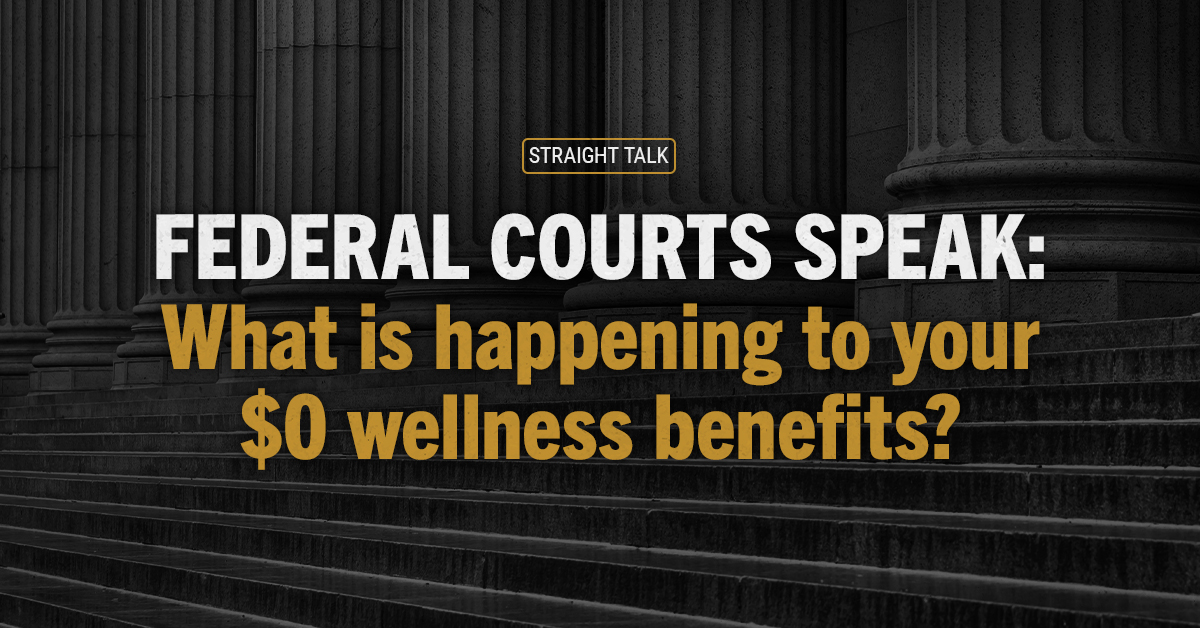What Is Happening to Your $0 Wellness Benefits?
I first became involved in the ACA (technically the Patient Protection and Affordable Care Act combined with the Health Care Education Reconciliation Act of 2010) way back in January 2009. By the time Congress passed the ACA in March 2010 , it had blossomed to 2,800 pages. Since this legislation was going to reform and reroute about 20% of our nation’s Gross Domestic Product, it makes sense that it was big.
In reading the final two bills that comprised the ACA, I and others noticed substantial gaps and contradictions. The public was assured these “would be fixed in the regulatory process after the bill is passed” by those who were in charge at the federal level in 2010.
Fast forward to 2023, and we are some 120,000 pages of regulatory repair into the process! So yeah, I’ve done a ton of reading over the past decade. And it is still ongoing. It makes sense when viewing the volume and scale of the changes that mistakes would be made, and some errors would creep into the healthcare product the ACA was trying to create. Since the bills created entirely new classes of winners and losers, it was expected that the losers wouldn’t just sit on their hands but would challenge the things in the law that disadvantaged them.
We are all going through one of those challenges now. And the results could affect how much you pay for certain healthcare services out of your pocket. As with so many challenges, this one hinges on a case in federal court and the way the ACA divvied out authority in its final form.
Why the ACA is Back in Court
In writing the ACA, it was determined that certain healthcare services could be so essential to a person’s well-being that if they had health insurance, those costs should be 100% absorbed by their insurance company and provided to the patient at $0. And the ACA’s authors recognized that they needed an expert and ongoing opinion on what those healthcare services should be and how important they are.
Among several candidates, the writers settled upon the United States Preventive Services Task Force (USPSTF) as the arbiter for many of the things they intended to force carriers to cover at $0. USPSTF is an all-volunteer research organization founded in 1983 to study evidence-based medicine. The ACA caused billions in research funding to be routed directly to this organization for analyzing potential inclusion of different medical services in all health insurance coverage. You can get a feel for the amount of research and money involved here.
To be clear, not ALL the items that require free coverage were determined by the USPSTF, but the majority of them were. The USPSTF grades medical services to determine their value to the patient and gives each of those services, screenings, medications, counseling sessions, tests and the like a grade of A through D. It’s often misunderstood, but the USPSTF does NOT do cost/benefit analysis. The price of a healthcare service is not considered at all in their analysis. Typically, they are looking at the question, “Does this extend someone’s life?”
The ACA specified anything USPSTF gave a grade of A or B was to be provided at $0 to the insured by all insurance plans (except grandfathered plans that remained unchanged for people on them as of March 23, 2010, who have stayed on those plans).
It’s quite a list nowadays, totaling 53 separate items. Here’s a link to the most current list of A/B coverage. You can also check out last year’s Straight Talk on updated recommendations from the USPSTF to lower the recommended age for colorectal cancer screening from 50 to 45, meaning Blue Cross and other insurers now cover this as a preventive screening for more members at a younger age.
So, What’s all the Fuss About?
Since employers, the biggest providers of health insurance for those of us under 65 years old, are required to offer every single service USPSTF grades A or B at $0, they often weigh in on whether they find the required coverage compatible with their business or values. Remember, the USPSTF grades value of a healthcare service WITHOUT consideration of the actual price.
A sizable group of employers recently found one of these requirements expensive and offensive enough to their sensibilities that they hired a prestigious group of attorneys to study the entire process by which USPSTF was granted their authority under the ACA, and how those recommendations turn into law. In their work they appear to have found a significant design flaw.
At least half of the $1 billion in research funding the USPSTF consumes each year comes from federal government allocations. Since, as we pointed out earlier, the governing body of the USPSTF is a group of volunteers who are not federal employees, nor are they approved by the U.S. Senate or the executive branch (as any other entity receiving that much federal money would be required to do), these attorneys said the creation of this responsibility and the entire process are invalid under federal law. They argue that for USPSTF to exercise that much power, the federal health secretary would need to have veto power over their recommendations. But, the ACA did not allow for that. As the law has been implemented to date, once USPSTF says it, it’s essentially the law of the land.
The businesses filed a lawsuit in federal court saying USPSTF recommendations could not carry the force of law based on the U.S. Constitution and needed to be set aside. That includes all 53 current and any future recommendations.
A few months ago, a federal judge in Dallas agreed with their contention on that specific point and said he needed to think about how to enforce his decision. As of March 29, we now know that he has told the federal government (specifically U.S. Centers for Medicare & Medicaid Services, IRS, Department of Labor) they cannot enforce ANY recommendation from the USPSTF as law. At this time, if an employer wants to NOT cover any USPSTF A or B recommendations, he potentially could exclude them from the employees’ health plan.
Potentially.
There Are Always Caveats to Consider in a Situation Like This
First, many states have adopted many of these A or B recommendations as mandates in state law. In that situation, health plans would have to cover them in their individual or fully insured group business. Larger, self-funded plans are usually federally regulated, so a state mandate might not apply to them.
Second, the decision implies carriers are free to continue to cover USPSTF recommendations in the absence of a state requirement, but they cannot be punished if they don’t.
Third, it may not be all that difficult to submit the governing body members of the USPSTF to the Senate and gain their approval to continue to carry out their mission. Or to have the president himself appoint USPSTF leadership to their posts, similar to what happens with other federal agencies.
Finally, the Department of Labor filed an appeal to this ruling in the 5th Circuit Court in New Orleans. Settling that may take a while (probably years), and it’s not a slam dunk that they will win. It appears the ACA writers took a bit of a shortcut by using the USPSTF to determine which services should be covered at $0, and now they will have to fix that.
How Does This Affect Me?
It’s important to note that the ACA mandate requiring carriers to cover birth control and vaccines comes from a different regulatory recommendation than the USPSTF. So, that requirement is still in force. Carriers in general like to cover well-researched wellness items as long as they show a real cost savings for members in the long run. This means many of the existing A or B recommendations may well survive, anyway. I don’t expect any of these mandated coverages to disappear in 2023. Going forward, it may be up to carriers and employers to decide how broad they want their $0 coverage to be. Carriers have already invested at least $50 billion in these A/B coverages (the real number may be much larger), which affects premium prices. Since USPSTF does not consider cost in their recommendations, only the value of a service, we really can’t use their research to make the argument that $0 coverages will “save money in the long run.” There is no analysis to support that.
The Straight Talk is, it’s not time to panic about these coverages just yet. Smart carriers will continue to cover things like annual checkups, mammograms, PAP smears, colonoscopies and many pharmaceuticals at $0 or very low cost because it’s cost-effective in the long run and makes sense to do so. Cost/benefit analysis can be done for the rest. Adjustments may be made in the future. Only time will tell.





Leave a Reply